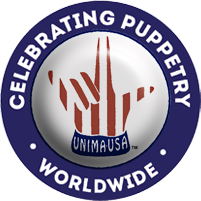SPOTLIGHT: KOREA
SPRING/SUMMER ISSUE NO. 57
Table of Contents • Editorial • Abstracts
Journeys to Korean Puppetry:
Guest editorial by Jungmin Song
Korean folklorist Choe Sang-su and American puppeteer Daniel Llords examining a deolmi made from a gourd, from Bak Cheom-ji Noreum. Courtesy of Münchner Stadtmuseum, Sammlung Puppentheater/Schaustellerei.
During my research trip to the Münchner Stadt museum (Munich City Museum)’s Puppet Theatre and Fairground Attraction collection, I found a set of photographs at the top of a drawer on U.S. puppetry that documented American puppeteer Daniel Llords’ tour of South Korea in the early 1960s. The images captured the moment when the folklorist Choe Sang-su introduced Llords to traditional Korean puppets and masks. It was totally unexpected to find photographs of 덜미 (deolmi)—Korean traditional rod puppets—among the U.S. materials in Germany. Yet the entwined histories of American and Korean puppetry make other appearances in the historical records. In À Propos, the precursor to Puppetry International, in 1975. A news item documented the journey of American puppeteer couple Bill and Mea Cassady, who arrived in South Korea as part of their year-long trip around the world searching for
puppetry in 1974 and 1975. When they inquired in Korea about extant forms of puppetry, the local tourist office informed them that puppetry did not exist in Korea. Undeterred, they pulled every string and managed to get in contact with performers of 꼭두각시놀음 kkokdugaksi noreum – a rod puppetry repertoire.
Throughout history, puppeteers and puppet enthusiasts in and outside of Korea have made efforts to preserve and promote Korean puppetry. However, compared to the puppet traditions of neighboring China and Japan, which have long been studied, appreciated, and influenced puppetry worldwide, Korean puppetry remains relatively unknown, not only abroad but even in Korea. Puppetry has yet to secure a prominent place in Korea’s performing arts culture.
The survival of traditional puppetry in Korea has largely depended on a handful of dedicated performers, scholars and government subsidies. This reliance on external support has made it difficult for the art form to evolve in ways that appeal to contemporary audiences. Nevertheless, a few younger artists, such as 연희공방 음마갱깽 (Theater Group Eumma), have been working tirelessly to continue and develop these traditions. Their efforts have recently gained national recognition and are beginning to build a dedicated following.
What is Korean puppetry today? Some might expect something ancient, traditional and exotic, in line with stereotypical views of puppetry in Asian countries. However, thanks to the global success of Korean cultural exports—K-pop, drama, cinema, food, and beauty products under the 한류 (Hallyu) label—Korean identity is no longer confined to a single aesthetic or form. These cultural products, shaped by long-term exposure to global influences and international exchanges, appeal to audiences worldwide while being considered quintessentially Korean.
The collection of articles in this issue explores the multifaceted nature of Koreanness as expressed through diverse puppetry practices. It introduces not only traditional Korean puppetry but also artists who have studied and worked abroad, bringing their knowledge back to Korea; practitioners of Korean heritage based outside Korea; puppets and puppeteers from abroad in Korean institutions; puppets in protest; puppets in higher education. This issue aims to go beyond simple artist introductions, offering dynamic perspectives on the history and future of Korean puppetry.
As we look ahead to the 2025 Chuncheon UNIMA Congress and World Puppet Festival, we see amplified echoes of past encounters, such as those of Llords and the Cassadys. My hope is that these articles will inspire and guide readers to connect with Korean puppetry, not only those who will be in Chuncheon this spring but also those aiming to connect with Korean puppetry in the future, coming from anywhere in the puppet world.




